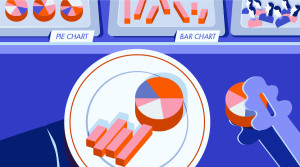I love dark chocolate, and I can justify my indulgence because it’s the healthiest of all chocolates. Vegetables, on the other hand, are not nearly as sexy; and at the risk of offending any vegans out there, I’d go so far as to say that vegetables are downright boring. Yet, there’s no doubt that eating more of them would be better for me in the long run—albeit less exciting.
American clothing merchant John Wanamaker is reputed to have said, “Half the money I spend on advertising is wasted; the trouble is I don’t know which half.” He understood that, if you can’t measure it, you can’t manage it. That applies as much to losing weight as it does to advertising. Problem is, businesses tend to jump on “the next big thing” like it’s the newest fad diet. Take Groupon. Formerly the media darling, Groupon’s business model is being called into question by investors and advertisers alike. In a blog post gone viral, one business owner called her decision to run a Groupon “the single worst decision I have ever made as a business owner thus far.”
Like dieting, advertising requires a bit of knowledge, a little common sense, and some math. But who wants to count calories when the South Beach Diet sounds so much sexier? Marketing with Groupon is sexy; LinkedIn, not so much. According to one author, LinkedIn’s lack of sex appeal is “a branding problem waiting to happen” and that “… Linkedin needs to act fast to fix it.”
Twitter … now that has sex appeal. After all, Kim Kardashian tweets, right? Apparently, most B2B marketers agree; a recent study shows that a whopping 91 percent of them use Twitter for business. But, oops … the same study also revealed that LinkedIn generates twice as many leads as Twitter. I guess sexy is as sexy does.
Just like my dark chocolate habit, what’s exciting isn’t always what works best. Take Yellow Pages. Everyone knows Yellow Pages are boring and obsolete … just ask any social media blogger, like the one who took an impromptu marketing survey in a roomful of people by asking, “Who has used the Yellow Pages in the past 3 months?” Seems that out of 300 people, only one person (in the back of the room, no less) raised their hand. Her conclusion? Yellow Pages are as extinct as the door-to-door encyclopedia salesman.
I’m sure her informal survey is much more accurate than the year-long study of 8,000 adults conducted by marketing research firm Burke, Inc. Rather than one out of 300, their study found that 74 percent used print Yellow Pages over the course of the year to find a local business—just slightly behind the 76 percent who used a search engine. Those percentages also illustrate that the average consumer uses more than one source when making a purchase decision.
Here are two things I’d like you to take away from this. The first one is: Be honest with your clients, and don’t push your own agenda on them. I’m probably in a unique position of having worked in both web marketing and Yellow Page industries, so I’m not tempted to pit one against another. I just like marketing that works. Make sure what you recommend is based on real data, not a biased opinion masquerading as fact. Many of my clients trusted me for marketing advice and I always tried to give them the advice that best suited their situation—even if that advice didn’t include me.
The second takeaway pertains to your own advertising and marketing. Forrest Gump’s momma said that “life is like a box of chocolates. You never know what you’re gonna get.” While that may be true about advertising and marketing, it doesn’t mean that, with a bit of testing and tracking, you can’t figure out what’s working and what’s not.
Blogging and social media are mostly free, but how much time do you invest compared to the return? If 25 hours a month online yields one client every two months, yet you get two new clients each month from 15 hours of cold-calling, where do you suppose your time is best spent?
I’m not saying that one method is better, but what I am saying is: Are you tracking it? Or are you doing what’s sexy and fun, but perhaps less effective? Don’t be like the 91 percent using Twitter and missing twice the amount of leads you could be getting from LinkedIn.
After all, sexy is as sexy does.
 John Tabita
John TabitaFormer owner and partner of web firm Jenesis Technologies, John is currently Director of Digital Strategy at Haines Local Search, a company providing local search marketing solutions to SMBs, including print and Internet Yellow Pages, web design, and local SEO. When not working or spending time with his family, John offers great sales and marketing advice on his blog, Small Business Marketing Sucks. When not working or spending time with his family, John offers great sales and marketing advice on his blog, Small Business Marketing Sucks.

